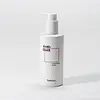What's inside
What's inside
 Key Ingredients
Key Ingredients

 Benefits
Benefits

 Concerns
Concerns

 Ingredients Side-by-side
Ingredients Side-by-side

Hydrolyzed Hyaluronic Acid
HumectantBuddleja Davidii Extract
Skin ConditioningGlycereth-26
HumectantImperata Cylindrica Root Extract
Skin ConditioningDimethicone/Vinyl Dimethicone Crosspolymer
Skin ConditioningSorbitan Oleate
EmulsifyingPotassium Sorbate
PreservativePentylene Glycol
Skin ConditioningCaprylyl Glycol
EmollientGlycerin
HumectantHippophae Rhamnoides Fruit Extract
Skin ConditioningWater
Skin ConditioningPotassium PCA
HumectantPhenoxyethanol
PreservativePEG-8
HumectantCyclopentasiloxane
EmollientPropanediol
SolventGlutathione
Parfum
MaskingNiacinamide
SmoothingDimethicone
EmollientDimethiconol
EmollientAdenosine
Skin ConditioningOpuntia Ficus-Indica Stem Extract
Skin ConditioningSodium Polyacrylate
AbsorbentEthylhexylglycerin
Skin ConditioningHydrolyzed Vegetable Protein
Skin ConditioningSodium Acrylate/Sodium Acryloyldimethyl Taurate Copolymer
Emulsion StabilisingPEG-Crosspolymer
Polysorbate 80
EmulsifyingThymus Vulgaris Flower/Leaf Extract
MaskingTitanium Dioxide
Cosmetic ColorantIsohexadecane
EmollientCarbomer
Emulsion StabilisingMaltodextrin
AbsorbentButylene Glycol
Humectant1,2-Hexanediol
Skin ConditioningCyclohexasiloxane
EmollientHydroxyethyl Acrylate/Sodium Acryloyldimethyl Taurate Copolymer
Emulsion StabilisingDisodium EDTA
Triethoxycaprylylsilane
Dipropylene Glycol
HumectantHydrolyzed Hyaluronic Acid, Buddleja Davidii Extract, Glycereth-26, Imperata Cylindrica Root Extract, Dimethicone/Vinyl Dimethicone Crosspolymer, Sorbitan Oleate, Potassium Sorbate, Pentylene Glycol, Caprylyl Glycol, Glycerin, Hippophae Rhamnoides Fruit Extract, Water, Potassium PCA, Phenoxyethanol, PEG-8, Cyclopentasiloxane, Propanediol, Glutathione, Parfum, Niacinamide, Dimethicone, Dimethiconol, Adenosine, Opuntia Ficus-Indica Stem Extract, Sodium Polyacrylate, Ethylhexylglycerin, Hydrolyzed Vegetable Protein, Sodium Acrylate/Sodium Acryloyldimethyl Taurate Copolymer, PEG-Crosspolymer, Polysorbate 80, Thymus Vulgaris Flower/Leaf Extract, Titanium Dioxide, Isohexadecane, Carbomer, Maltodextrin, Butylene Glycol, 1,2-Hexanediol, Cyclohexasiloxane, Hydroxyethyl Acrylate/Sodium Acryloyldimethyl Taurate Copolymer, Disodium EDTA, Triethoxycaprylylsilane, Dipropylene Glycol
Water
Skin ConditioningCoco-Glucoside
CleansingMethyl Perfluoroisobutyl Ether
SolventAcrylates Copolymer
Cellulose
AbsorbentGlycerin
HumectantPotassium Cocoyl Glycinate
Portulaca Oleracea Extract
Skin ConditioningCentella Asiatica Extract
CleansingMadecassoside
AntioxidantAsiaticoside
AntioxidantBiosaccharide Gum-4
Skin ConditioningDextrin
AbsorbentButylene Glycol
HumectantSodium Hydroxide
BufferingDisodium EDTA
Phenoxyethanol
Preservative1,2-Hexanediol
Skin ConditioningParfum
MaskingLimonene
PerfumingWater, Coco-Glucoside, Methyl Perfluoroisobutyl Ether, Acrylates Copolymer, Cellulose, Glycerin, Potassium Cocoyl Glycinate, Portulaca Oleracea Extract, Centella Asiatica Extract, Madecassoside, Asiaticoside, Biosaccharide Gum-4, Dextrin, Butylene Glycol, Sodium Hydroxide, Disodium EDTA, Phenoxyethanol, 1,2-Hexanediol, Parfum, Limonene
Ingredients Explained
These ingredients are found in both products.
Ingredients higher up in an ingredient list are typically present in a larger amount.
1,2-Hexanediol is a synthetic liquid and another multi-functional powerhouse.
It is a:
- Humectant, drawing moisture into the skin
- Emollient, helping to soften skin
- Solvent, dispersing and stabilizing formulas
- Preservative booster, enhancing the antimicrobial activity of other preservatives
Butylene Glycol (or BG) is used within cosmetic products for a few different reasons:
Overall, Butylene Glycol is a safe and well-rounded ingredient that works well with other ingredients.
Though this ingredient works well with most skin types, some people with sensitive skin may experience a reaction such as allergic rashes, closed comedones, or itchiness.
Learn more about Butylene GlycolDisodium EDTA plays a role in making products more stable by aiding other preservatives.
It is a chelating agent, meaning it neutralizes metal ions that may be found in a product.
Disodium EDTA is a salt of edetic acid and is found to be safe in cosmetic ingredients.
Learn more about Disodium EDTAGlycerin is already naturally found in your skin. It helps moisturize and protect your skin.
A study from 2016 found glycerin to be more effective as a humectant than AHAs and hyaluronic acid.
As a humectant, it helps the skin stay hydrated by pulling moisture to your skin. The low molecular weight of glycerin allows it to pull moisture into the deeper layers of your skin.
Hydrated skin improves your skin barrier; Your skin barrier helps protect against irritants and bacteria.
Glycerin has also been found to have antimicrobial and antiviral properties. Due to these properties, glycerin is often used in wound and burn treatments.
In cosmetics, glycerin is usually derived from plants such as soybean or palm. However, it can also be sourced from animals, such as tallow or animal fat.
This ingredient is organic, colorless, odorless, and non-toxic.
Glycerin is the name for this ingredient in American English. British English uses Glycerol/Glycerine.
Learn more about GlycerinParfum is a catch-all term for an ingredient or more that is used to give a scent to products.
Also called "fragrance", this ingredient can be a blend of hundreds of chemicals or plant oils. This means every product with "fragrance" or "parfum" in the ingredients list is a different mixture.
For instance, Habanolide is a proprietary trade name for a specific aroma chemical. When used as a fragrance ingredient in cosmetics, most aroma chemicals fall under the broad labeling category of “FRAGRANCE” or “PARFUM” according to EU and US regulations.
The term 'parfum' or 'fragrance' is not regulated in many countries. In many cases, it is up to the brand to define this term.
For instance, many brands choose to label themselves as "fragrance-free" because they are not using synthetic fragrances. However, their products may still contain ingredients such as essential oils that are considered a fragrance by INCI standards.
One example is Calendula flower extract. Calendula is an essential oil that still imparts a scent or 'fragrance'.
Depending on the blend, the ingredients in the mixture can cause allergies and sensitivities on the skin. Some ingredients that are known EU allergens include linalool and citronellol.
Parfum can also be used to mask or cover an unpleasant scent.
The bottom line is: not all fragrances/parfum/ingredients are created equally. If you are worried about fragrances, we recommend taking a closer look at an ingredient. And of course, we always recommend speaking with a professional.
Learn more about ParfumPhenoxyethanol is a preservative that has germicide, antimicrobial, and aromatic properties. Studies show that phenoxyethanol can prevent microbial growth. By itself, it has a scent that is similar to that of a rose.
It's often used in formulations along with Caprylyl Glycol to preserve the shelf life of products.
Water. It's the most common cosmetic ingredient of all. You'll usually see it at the top of ingredient lists, meaning that it makes up the largest part of the product.
So why is it so popular? Water most often acts as a solvent - this means that it helps dissolve other ingredients into the formulation.
You'll also recognize water as that liquid we all need to stay alive. If you see this, drink a glass of water. Stay hydrated!
Learn more about Water